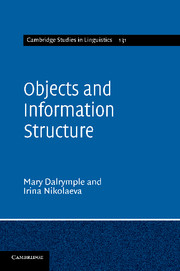Book contents
- Frontmatter
- Contents
- Preface and Acknowledgements
- List of Abbreviations
- 1 Introduction
- 2 Syntactic assumptions
- 3 Information structure in grammar
- 4 Syntax and information structure
- 5 Topicality and grammatical marking
- 6 Topical marking of nonsubjects
- 7 Topicality and DOM
- 8 Primary and secondary objecthood and DOM
- 9 Multiple objects and grammatical alignment
- 10 Semantic features, topicality and grammaticalisation
- 11 Conclusion
- References
- Author Index
- Language Index
- Subject Index
8 - Primary and secondary objecthood and DOM
Published online by Cambridge University Press: 05 October 2012
- Frontmatter
- Contents
- Preface and Acknowledgements
- List of Abbreviations
- 1 Introduction
- 2 Syntactic assumptions
- 3 Information structure in grammar
- 4 Syntax and information structure
- 5 Topicality and grammatical marking
- 6 Topical marking of nonsubjects
- 7 Topicality and DOM
- 8 Primary and secondary objecthood and DOM
- 9 Multiple objects and grammatical alignment
- 10 Semantic features, topicality and grammaticalisation
- 11 Conclusion
- References
- Author Index
- Language Index
- Subject Index
Summary
In this chapter we discuss languages where marked (topical) objects are grammatically distinguished from unmarked (nontopical) objects: marked and unmarked objects have different syntactic behaviour, with marked objects exhibiting more properties of core grammatical functions than unmarked objects. We concentrate on marking patterns with monotransitive verbs in this chapter; Chapter 9 discusses marking and alignment patterns for multivalent verbs, with particular attention to languages with ditransitive constructions.
Grammatical marking and grammatical function
There are two basic patterns of interaction between the grammatical marking of nonsubject topics (DOM) and grammatical objecthood. In languages of the first type, a difference in object marking does not correlate with a difference in grammatical function. Such patterns are not surprising in the context of traditional theories of argument mapping, discussed in Chapter 2, Section 2.1.2, which define possible relations between grammatical functions and semantic roles as they are represented at argument structure. On this view, we would expect marked and unmarked objects which correspond to the same semantic role to be mapped to the same grammatical function, and there is no expectation that information-structure role could affect argument mapping.
The languages discussed in Chapter 7 are of this type. In these languages, DOM is defined in terms of information-structure role, sometimes in combination with semantics, and not grammatical function. Grammatically marked and unmarked objects do not display behavioural syntactic differences: grammatical marking correlates with information structure differences — topical vs. nontopical arguments — and does not reflect a difference in grammatical function.
Information
- Type
- Chapter
- Information
- Objects and Information Structure , pp. 140 - 168Publisher: Cambridge University PressPrint publication year: 2011
